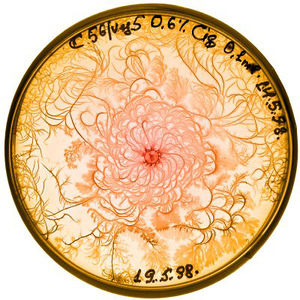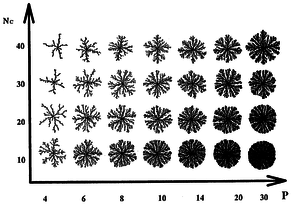Patterns of Bacterial Growth
Introduction
For the purposes of identifying patterns of growth, bacteria colonies can be through of as multicellular organisms. (info about communication)
Patterns of growth are a result of bacteria adapting their behavior to suit their environment.
Select a topic that includes microbes (bacteria, protist, fungi, or algae). Any kind of topic is possible, because all living organisms and ecosystems include microbes. For example, Google "kangaroo bacteria".
Compose a title for your page. Type your exact title in the Search window, then press Go. The MicrobeWiki will invite you to create a new page with this title.
Open the class template page in "edit." Copy ALL the editable text. Then go to YOUR OWN page; edit tab. PASTE into your own page, and edit.
At right is a sample image insertion. It works for any image uploaded anywhere to MicrobeWiki. The insertion code consists of:
Double brackets: [[
Filename: PHIL_1181_lores.jpg
Thumbnail status: |thumb|
Pixel size: |300px|
Placement on page: |right|
Legend/credit: Electron micrograph of the Ebola Zaire virus. This was the first photo ever taken of the virus, on 10/13/1976. By Dr. F.A. Murphy, now at U.C. Davis, then at the CDC.
Closed double brackets: ]]
Other examples:
Bold
Italic
Subscript: H2O
Superscript: Fe3+
Diffusion-Limited Aggregation
Diffusion-Limited Aggregation (DLA) is a growth model that results in complex, multi-branched forms. It can be applied to any system where diffusion is the main method of particle transportation. It can be observed in bacterial growth on agar plates, dendrites, dust balls, electrodeposition, and mineral deposits.
To form a DLA pattern, begin with a seed molecule at the origin of the lattice. A "random walker" molecule diffuses from far away in a random pattern of motion. It stops once it reaches a space adjacent to the seed molecule, and another random walker is launched. In a DLA lattice, a molecule that sticks out of a main branch will not be rounded or smoothed over by new growth, but rather emphasized. Nodes are more likely to catch wandering particles because they three facets available for growth, compared to a molecule in the branch, which only has one facet.
Agar Density
Include some current research, with at least one image.
Nutrient Density
Include some current research, with a second image.
Conclusion
Overall text length should be at least 1,000 words (before counting references), with at least 2 images. Include at least 5 references under Reference section.
References
Edited by Eleanor Lopatto, student of Joan Slonczewski for BIOL 116 Information in Living Systems, 2013, Kenyon College.



